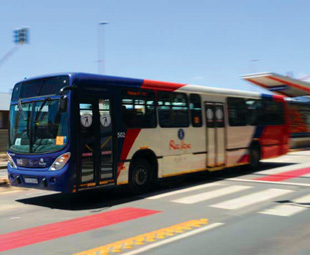Start saving for legal fees

It is time South Africans start to question bogus future developments in public transport.
I was wondering whether to use this opportunity to describe the latest introduction of bus rapid transit (BRT) in Johannesburg, which is (at the time of writing) into its fourth week. It is a service with good potential, but is likely to flounder because of poor integration with other services.
But there is a more pressing issue … Now that the e-toll saga seems to have died down, leaving members of the community several million rand poorer due to legal fees, we need to focus on subtle moves to soften us up for yet more bogus future developments in public transport. We need to question them now, and not wake up five years after the contracts have been signed.
Two months ago this column referred to the lack of a passenger transport plan for Gauteng; a serious problem that requires a robust response. But what did we get? More spin from people who should know better. In an article in Business Day (October 30), a property developer says that “the additional 140 km of (Gautrain) rail announced as part of the 25-year transport plan for Gauteng has been well received”. Notice the hubris – “announced” by whom?
“Feasibility studies still need to be undertaken … route specifics will be determined … a budget will be decided once the preliminary investigations have been concluded and there is more clarity on costs and funding methods”. No mention that Gautrain is currently an underperforming disaster, taking only 25 000 cars off the road. (Actually not off the road – they merely travel a shorter distance to the nearest station.)
Public transport should by now be taking more than 100 000 cars off the road, but there is little hope of this unless these fancy schemes are integrated with a basic network of road-based services throughout the province.
 No mention of that, though: Gautrain was “not a stand-alone project” but was being “developed as part of a holistic approach. It would dovetail with the Passenger Rail Agency of SA … system and the BRT systems (in) Johannesburg and Tshwane … to form an integrated whole”. “Not a stand-alone project” and “as part of a holistic approach” are cut-and-paste phrases taken from documents published more than ten years ago when the Gautrain was first “announced”.
No mention of that, though: Gautrain was “not a stand-alone project” but was being “developed as part of a holistic approach. It would dovetail with the Passenger Rail Agency of SA … system and the BRT systems (in) Johannesburg and Tshwane … to form an integrated whole”. “Not a stand-alone project” and “as part of a holistic approach” are cut-and-paste phrases taken from documents published more than ten years ago when the Gautrain was first “announced”.
Then, more spin, this time from the academic world – the Gauteng City-Region Observatory (GCRO), a collaborative project between the University of Johannesburg, Wits University and the Gauteng provincial government. (“Collaboration” involving academics already makes one question the independence of the work that they produce.)
In its latest report, quoted in Business Day of October 28, the GCRO has roped in the University of Pretoria to assist with “observing”. They found that “South Africans need a greater ability to travel to workplaces, clinics and other services if the country is to meet the National Development Plan goal of eliminating poverty and reducing inequality by 2030.” Gee whiz, groundbreaking stuff!
The GCRO also “observed” that the townships with the easiest access to public transport were the central ones such as Soweto and Alexandra. Other areas, such as Hammanskraal and Katlehong, were “short-changed”. But, according to one of the directors of the GCRO, “It’s a golden age of transport in Gauteng”. Why the confidence? “Among an array of transport initiatives we have the second phase of Johannesburg’s (BRT) system, the start of planning for seven new Gautrain routes and Prasa’s commissioning of new rolling stock”.
New this, new that – but no reference to fixing what is already there or getting better value for money by reorganising existing services.
Just to underscore how far behind the curve we are, Johannesburg is now asking for consultants to assist its underperforming Metrobus service with “Implementation of Automatic Fare Collection and Advanced Public Transport Management System”. One would have thought that fare collection decisions would have already been taken at a provincial level and the ground rules would have been spelt out to all operators. But we still seem to have individual operators making decisions on fare collection systems!
So my advice, based on all this, is that having wasted many millions on legal fees to fight the e-toll scheme, we should start saving up for the next round of legal action, say by 2020 or thereabouts. Maybe the National Treasury could also ask the Reserve Bank to start printing notes to pay for all this. Will we ever learn?
Vaughan Mostert is a senior lecturer in the Department of Transport and Supply Chain Management at the University of Johannesburg. He developed a love for public transport early in life, which led to a lifelong academic interest in the subject. Through Hopping Off, Mostert leaves readers with some parting food for thought as he continues his push for change in the local public transport industry.
Published by
Focus on Transport
focusmagsa




